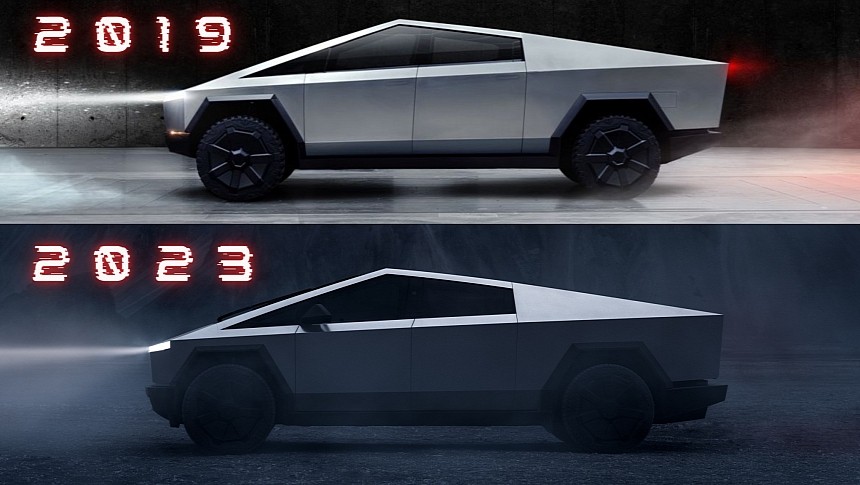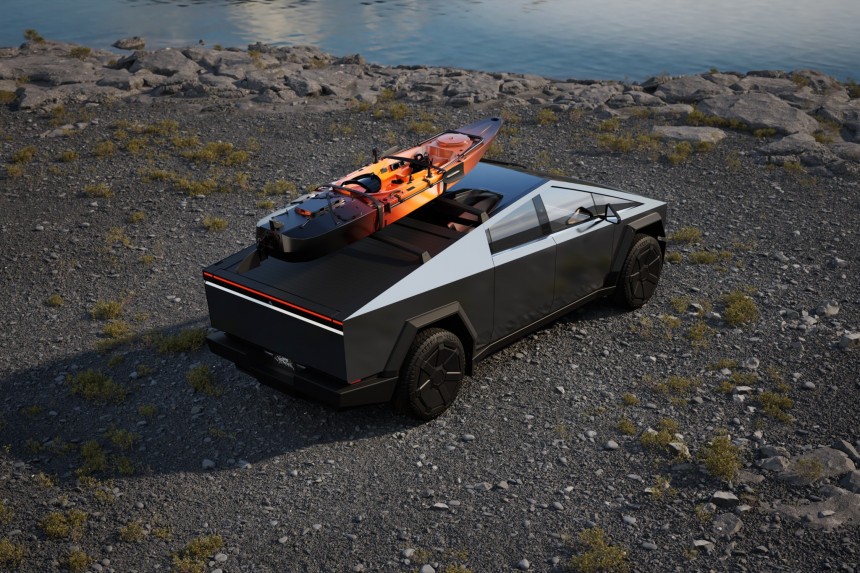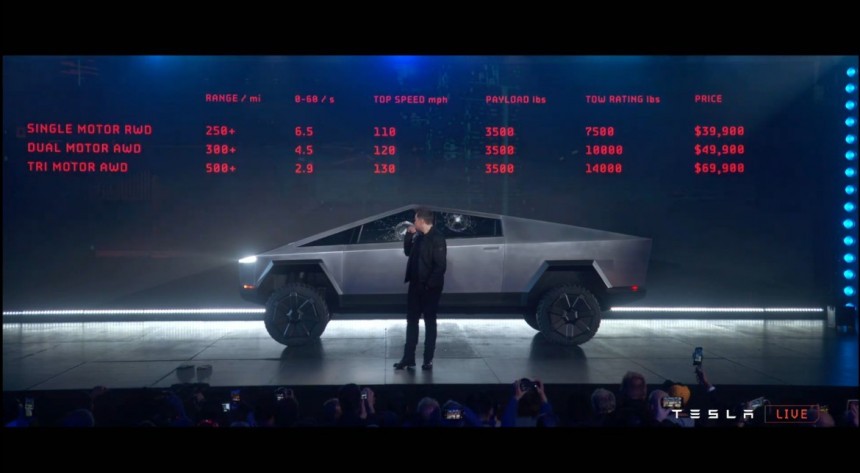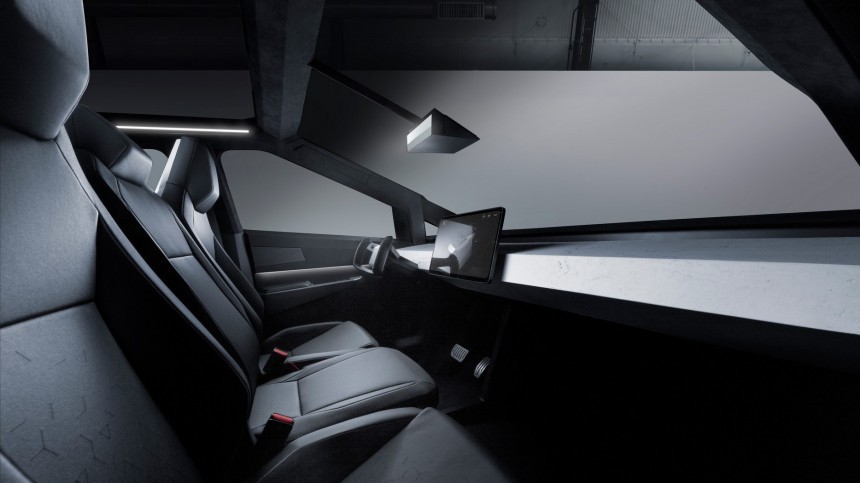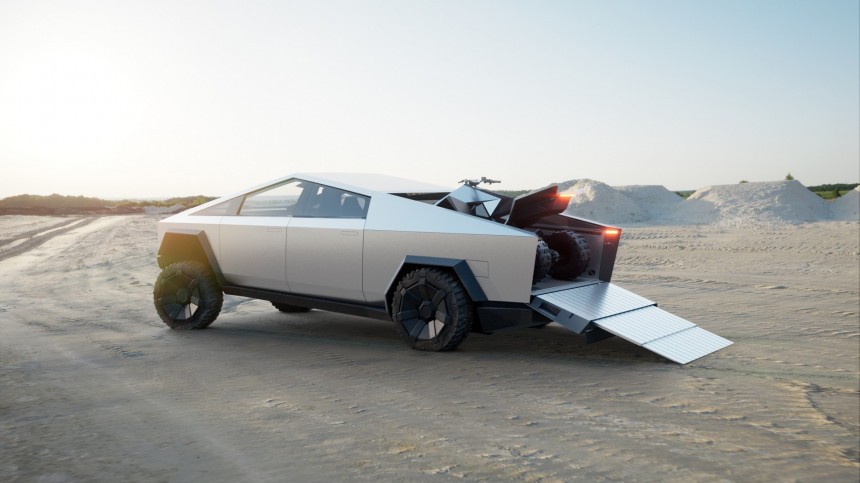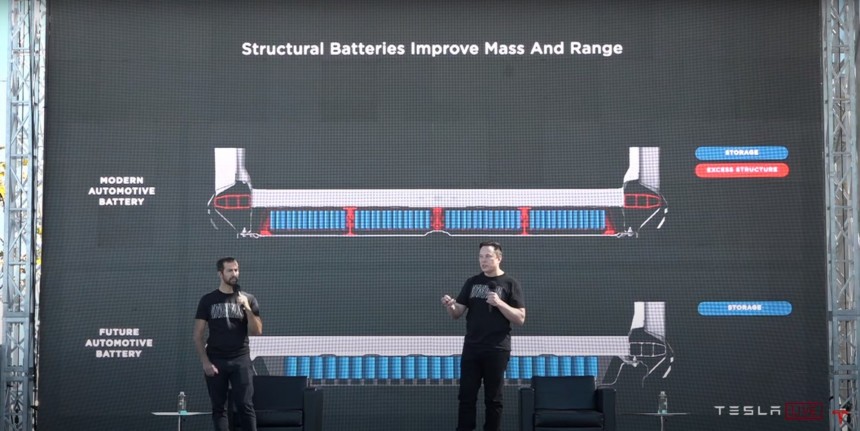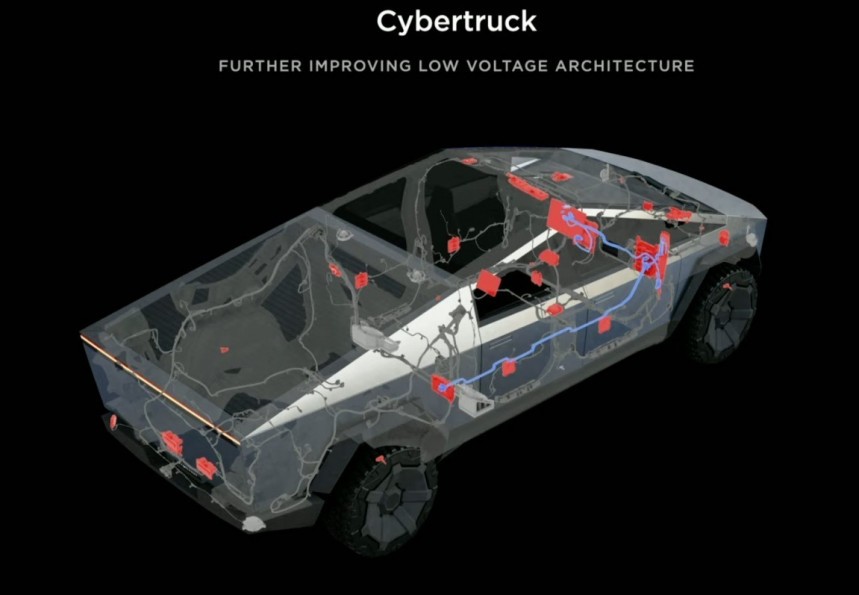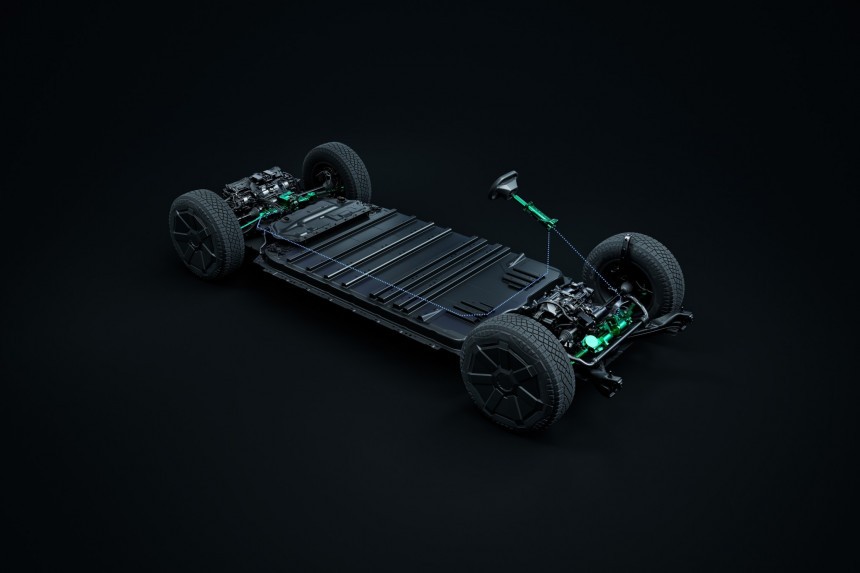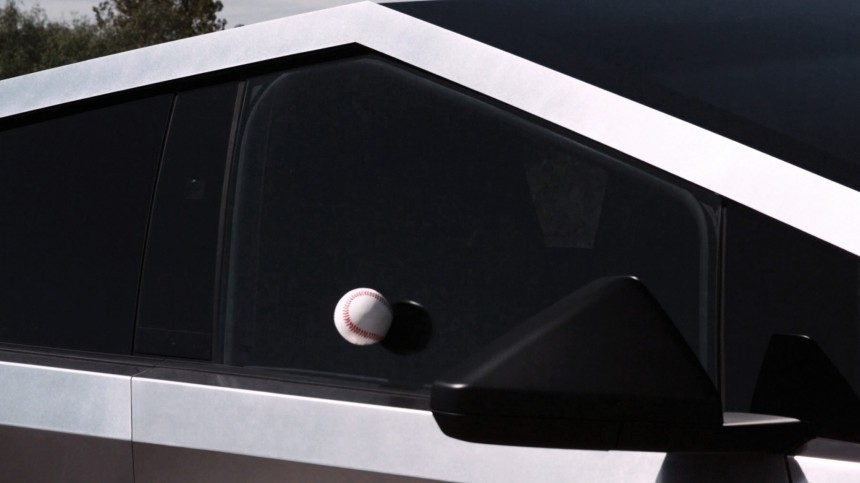Tesla Cybertruck was unveiled in 2019 after Elon Musk cozied up with the truck idea for at least four years. What was meant to be the first electric pickup ever turned out a tough nut to crack for Tesla, with production delayed about two years. Even so, the Cybertruck in production today is vastly different from the one unveiled in 2019.
When Tesla introduced the Cybertruck on stage four years ago, Elon Musk presented it as a revolutionary product that no one had attempted to make before. The Cybertruck was initially planned to start production in late 2021. However, the pandemic turned the world upside down in 2020, and the industrial thaw saw the supply chains disrupted in the years that followed. This took a toll on the Cybertruck's development, delaying production start.
Tesla also revised the Cybertruck project repeatedly, making it more of a rolling project, with features added and removed all the time. This also pushed back the completion of the development phase until 2022. In April 2020, Musk announced shrinking the Cybertruck by "about 3%" compared to the original prototype. Tesla announced adding four-wheel steering in 2021, as well as a four-motor variant. The former made it into production, while the latter was abandoned, but it caused more delays nevertheless.
By the time Tesla was ready to produce the first pre-production vehicles, other carmakers were already controlling the electric pickup market segment. This in itself doesn't mean anything, as the Tesla Cybertruck could still upend the market. After all, Apple was late to the smartphone market when it launched the iPhone. Tesla was also late to the automotive industry and is now producing the world's most-sold vehicle, the Model Y.
The modifications Tesla operated to the Cybertruck during the past four years mean that the model in production today is very different from the one announced in 2019. Some features of the original project have not made it into production, while others have been added. Some people might be disappointed about the former, while others appreciate the latter. It's high time we revise the most important features scrapped and those added.
Instead of having more range than the AWD model, the tri-motor Cybertruck can only go 320 miles on a charge. The initial plan was for the top-of-the-line Cybertruck to feature a bigger battery pack, thus enabling more range. The reality is that the Cyberbeast shares the same 123-kWh pack with the dual-motor Cybertruck, and the additional motor can only lower that range estimate. It's unclear why Tesla chose blame over range, but the lower-than-expected performance of the 4680 cells could be the culprit.
When the Cybertruck was announced, things were looking brightly on the battery cell front. Tesla just completed the Maxwell takeover in May 2019, and the promises of the dry-battery-electrode technology seemed within its grasp. Four years later, the technology is still not yielding the results Tesla had hoped for.
This is why Tesla slipped an upcoming "range extender" in the Cybertruck's specifications, promising to add up to 130 miles while taking up space in the truck's bed. My guess is that this piggyback battery will never be produced, as it's too expensive ($16,000) and cumbersome to make sense. Even with the range extender, the Cyberbeast will only get 440 miles of range.
That's not to say that carmakers have tried, at times, to put three seats in front, although having an additional airbag for the center passenger is complicated. Still, the trend has not caught up, although many believed Tesla would change things around. Alas, it didn't, and this became clear as soon as the first prototypes were spotted on public roads earlier this year.
The Cybertruck's front center seat was supposed to fold, turning into a table or desk, making the cabin more functional. In the end, Tesla chose to simplify things, opting for a center console instead. It still features storage spaces and is big enough to support things like a laptop or a food tray, but you can only sit there at your own risk.
However, Tesla must've considered it challenging to implement from an engineering standpoint. Many things could've broken, especially considering the dirt that could enter the tailgate during normal operation. Regardless of considerations, the production Cybertruck doesn't have a ramp. The tailgate is also rather basic, at least compared to other smart tailgates in the industry.
Tesla is offering a $400 tailgate ramp as an accessory for the Cybertruck, but it looks more like a tri-fold ladder than a ramp. You'll need two of these if you want to load a vehicle like the Cyberquad, so prepare to fork out $800 for a make-shift contraption. The good part is that the ramp can be folded small enough to fit the gear locker under the bed's floor—a small consolation compared to the original idea.
It's hard to understand why Tesla skimped on this feature, considering that the Cybertruck needs to produce its own air anyway. The adaptive suspension works by pumping air into the suspension chambers to adjust ride height and road handling. Still, the Cybertruck keeps this air to itself, with no air outlet offered for external equipment.
The possibility of Tesla offering this feature is slim to none, considering that it sells an air compressor in the accessory shop. According to the description, this tool provides programmable presets and automatic inflate/deflate modes thanks to its digital controls. That's pretty much what every portable tire inflator does these days. And for $550, it's highway robbery.
The Cybertruck Delivery Day event came and went without any word about the Cybertruck's ability to float. This must've been such a relief for Tesla's legal team because people trying to cross a body of water with the Cybertruck could quickly turn into a liability nightmare. Even so, I'm sure we're going to see people sink a Cybertruck while trying to prove that it floats.
Even if it doesn't, the Cybertruck should be perfectly capable of fording a river, provided the water is not too deep. Thanks to its impressive ground clearance of up to 17.4 inches (440 mm), the Cybertruck should have no problem. It also comes with a "Wade Mode," which is supposed to raise the ride height and pressurize the battery pack when driving through water.
The most important takeaway from the 2020 event was the adoption of a bigger form factor, named 4680, after the cell's dimension (46 mm thick, 80 mm tall). Tesla touted five times more energy, 16% more range, and six times more power from the bigger cells. They were also instrumental in creating structural battery packs that could reduce weight by eliminating other structural elements from the vehicle. This must've weighed heavily on Tesla's hopes for a 500-mile Cybertruck.
However, as the first structural battery packs were installed in the Model Y, it became clear that the 4680 cells were not on par with their 2170 counterparts. The energy density was lower, and the charging curve was disappointing. The Cybertruck is fitted with the second generation of Tesla's 4680 cells, sporting improved energy density, but how they fare in real life remains to be seen. What's clear is that a 500-mile Cybertruck is off the table for now.
The Cybertruck is the first production vehicle to come with a 48-volt electrical system. This means that all the electrical components, from the HVAC blower to window motors and actuators, had to be developed from scratch. Without economy of scale, I'm sure Tesla is selling the Cybertruck below costs, which is why it wants other carmakers to adopt the higher voltage as soon as possible.
To accelerate the adoption, Tesla offered the 48-volt electrical system whitepaper to all industry leaders. Ford CEO Jim Farley confirmed it got a copy and agreed to "help the supply base move into the 48-volt future." The Cybertruck may be the first, but Tesla plans to switch all its EVs, as well as the Optimus Bot, to a 48-volt electrical architecture.
To be fair, rear-wheel steering almost requires a steer-by-wire system, considering how complicated it is to have the rear wheels physically connected to the steering wheel. Tesla made the necessary step to also use an electronic system for the front wheels. There is no physical connection between the steering wheel and the Cybertruck's wheels, which are steered courtesy of two actuator motors on the front axle (redundancy) and one on the rear axle.
Tesla also connected everything using a Gigabit Ethernet communication backbone with Power over Ethernet to simplify wiring. This is a first for the automotive world, but the system will be further refined and optimized for future models. The next-generation EVs (including the $25,000 model) will feature a new modular wiring system, which will eliminate the manual installation of wiring harnesses.
It can send up to 11.5 kW to your house should the need arise, which is higher than what the competition is offering. To use this functionality, you need to have Tesla's Gateway and the Universal Wall Connector. Those who already have a Powerwall and the Wall Connector don't need to add anything to make it work.
The Cybertruck also features four 120-volt outlets (two in the cabin and two in the bed), as well as a 240-volt outlet. The latter supports up to 40 amps for a total of 9.6 kW of continuous power. If that's not enough, you can add additional 120-volt and 240-volt outlets via the Powershare Mobile Connector and Outlet Adapters (up to 32 amps).
During the Delivery Day event, Elon Musk invited Tesla's chief designer to repeat the steel ball demonstration. However, this time, Franz used a baseball and, to play it safely, gently lobbed the ball at the Cybertruck's window. Lately, we've found out that the very Cybertruck unit on stage (VIN002) would become his vehicle, explaining why he was so shy about the windows.
Tesla still claims on its website that the Cybertruck's windows are "shatter-resistant." They should withstand the impact of a baseball at 70 mph or class 4 hail. I'm not sure what this means in practice, but we know that hard objects can still break them. And this is not bad, considering that you should be able to break the glass and escape the vehicle in an emergency.
Tesla also revised the Cybertruck project repeatedly, making it more of a rolling project, with features added and removed all the time. This also pushed back the completion of the development phase until 2022. In April 2020, Musk announced shrinking the Cybertruck by "about 3%" compared to the original prototype. Tesla announced adding four-wheel steering in 2021, as well as a four-motor variant. The former made it into production, while the latter was abandoned, but it caused more delays nevertheless.
By the time Tesla was ready to produce the first pre-production vehicles, other carmakers were already controlling the electric pickup market segment. This in itself doesn't mean anything, as the Tesla Cybertruck could still upend the market. After all, Apple was late to the smartphone market when it launched the iPhone. Tesla was also late to the automotive industry and is now producing the world's most-sold vehicle, the Model Y.
The modifications Tesla operated to the Cybertruck during the past four years mean that the model in production today is very different from the one announced in 2019. Some features of the original project have not made it into production, while others have been added. Some people might be disappointed about the former, while others appreciate the latter. It's high time we revise the most important features scrapped and those added.
Tesla Cybertruck features that were omitted from the production model
There are always people who only see the glass as half empty. These people want to make a point that the Cybertruck arrived too late and offers too little to make a dent in the market. They also said the Cybertruck is ugly as hell, and who would want one since Tesla is not going to make it anyway? Well, despite critics, the Cybertruck is real, and it's now rolling off the production line at Giga Texas. However, things are missing from the production model compared to what Tesla promised in 2019.500 miles of range
This is probably the biggest disappointment even for the Cybertruck's die-hard fans. According to the initial specifications, the Tesla Cybertruck should've offered 250 miles of range for the RWD variant, 300 miles for the AWD version, and 500 miles for the tri-motor setup. Looking at the dual-motor Cybertruck, the production model surpassed expectations with 340 miles of range. I expect the RWD variant to also do better than the 250 miles promised in 2019. However, the Cyberbeast is a different story.When the Cybertruck was announced, things were looking brightly on the battery cell front. Tesla just completed the Maxwell takeover in May 2019, and the promises of the dry-battery-electrode technology seemed within its grasp. Four years later, the technology is still not yielding the results Tesla had hoped for.
This is why Tesla slipped an upcoming "range extender" in the Cybertruck's specifications, promising to add up to 130 miles while taking up space in the truck's bed. My guess is that this piggyback battery will never be produced, as it's too expensive ($16,000) and cumbersome to make sense. Even with the range extender, the Cyberbeast will only get 440 miles of range.
Six seats (with front middle seat)
The original Cybertruck and the first official renderings Tesla provided showed a six-seat cabin with the front row having three seats. This was reminiscent of the times when pickup trucks had a bench so that a family could share the front row (or rather the only raw). Modern safety standards changed that, and individual seats in front rows became the norm, even for commercial vehicles.The Cybertruck's front center seat was supposed to fold, turning into a table or desk, making the cabin more functional. In the end, Tesla chose to simplify things, opting for a center console instead. It still features storage spaces and is big enough to support things like a laptop or a food tray, but you can only sit there at your own risk.
Integrated tailgate ramp
This was one of the coolest features of the Cybertruck. The telescopic ramp would deploy to allow the Cyberquad to board and unload. Apart from the 2019 unveiling, we've also seen the tailgate ramp on a prototype in 2021, although it looked flimsy and poorly designed. The telescopic ramp featured in the Cybertruck renderings consisted of two segments extending from the tailgate.Tesla is offering a $400 tailgate ramp as an accessory for the Cybertruck, but it looks more like a tri-fold ladder than a ramp. You'll need two of these if you want to load a vehicle like the Cyberquad, so prepare to fork out $800 for a make-shift contraption. The good part is that the ramp can be folded small enough to fit the gear locker under the bed's floor—a small consolation compared to the original idea.
Integrated air compressor
This could've been an easy win for Tesla, but it decided against offering one. Having an air compressor in the Cybertruck could be extremely useful for adventure lovers. Even if you don't need to top-up the tires that often, the possibility of inflating sports and camping equipment without giving it a thought is reassuring. Especially when the Rivian R1T has an integrated air compressor.The possibility of Tesla offering this feature is slim to none, considering that it sells an air compressor in the accessory shop. According to the description, this tool provides programmable presets and automatic inflate/deflate modes thanks to its digital controls. That's pretty much what every portable tire inflator does these days. And for $550, it's highway robbery.
Floating on water
I admit, this wasn't in the original presentation, although Elon Musk appeared quite serious about making the Cybertruck amphibious in 2020. I'm sure he gave it more than a thought because, last year, Musk raised the stakes by claiming the Cybertruck would be "waterproof enough to serve briefly as a boat." According to Musk, the Cybertruck should be perfectly capable of crossing the channel from Starbase to South Padre Island.Even if it doesn't, the Cybertruck should be perfectly capable of fording a river, provided the water is not too deep. Thanks to its impressive ground clearance of up to 17.4 inches (440 mm), the Cybertruck should have no problem. It also comes with a "Wade Mode," which is supposed to raise the ride height and pressurize the battery pack when driving through water.
Tesla Cybertruck features that were added later into development
Although not all the features from the original project or those considered later made it to the production model, the Cybertruck also has some killer features that no one saw coming. As usual, Tesla surprised us even though the Cybertruck has been in the open for everyone to see for the past year. Some of them are certainly more important than the missing tailgate ramp or the front middle seat, considering the potential to change the automotive industry.The 4680-cell structural battery pack
Although the 4680 cells were never mentioned during the Cybertruck unveiling event in 2019, Tesla certainly had the plans already made up at the time. Months before the event, the EV market leader incorporated Maxwell, the company behind the dry electrode manufacturing process. This was a crucial element in producing cheap, energy-dense Li-ion battery cells. All these plans were revealed in September 2020 during Battery Day.However, as the first structural battery packs were installed in the Model Y, it became clear that the 4680 cells were not on par with their 2170 counterparts. The energy density was lower, and the charging curve was disappointing. The Cybertruck is fitted with the second generation of Tesla's 4680 cells, sporting improved energy density, but how they fare in real life remains to be seen. What's clear is that a 500-mile Cybertruck is off the table for now.
The 48-volt electrical system
Although Tesla didn't announce a 48-volt electrical system for the Cybertruck in 2019, this happened in March, during Investor Day. This made it less of a surprise on the Delivery Day in November, although it's still a groundbreaking feature. The 48-volt electrical system is crucial for the Cybertruck, as it features power-hungry components that can use the higher voltage to save on wiring.To accelerate the adoption, Tesla offered the 48-volt electrical system whitepaper to all industry leaders. Ford CEO Jim Farley confirmed it got a copy and agreed to "help the supply base move into the 48-volt future." The Cybertruck may be the first, but Tesla plans to switch all its EVs, as well as the Optimus Bot, to a 48-volt electrical architecture.
Steer by wire/Four-wheel steering
This was probably Cybertruck's best-kept secret. Although we knew Tesla's electric pickup would feature rear-wheel steering, nobody anticipated a steer-by-wire system. Rumors about such a system developed by Tesla surfaced for the first time in June, albeit indicating that the Model 3 Highland would have it. It turned out that the Model 3 would not have any new groundbreaking features. Instead, the Cybertruck was the first model to come with a steer-by-wire system.Tesla also connected everything using a Gigabit Ethernet communication backbone with Power over Ethernet to simplify wiring. This is a first for the automotive world, but the system will be further refined and optimized for future models. The next-generation EVs (including the $25,000 model) will feature a new modular wiring system, which will eliminate the manual installation of wiring harnesses.
Powershare bi-directional charging
Although the Cybertruck is not the first electric vehicle to feature bi-directional charging, it's Tesla's first step in this direction. It might have taken a long time for it to jump on board, but Tesla's Powershare is one of the most powerful vehicle-to-load (V2L) systems on the market.The Cybertruck also features four 120-volt outlets (two in the cabin and two in the bed), as well as a 240-volt outlet. The latter supports up to 40 amps for a total of 9.6 kW of continuous power. If that's not enough, you can add additional 120-volt and 240-volt outlets via the Powershare Mobile Connector and Outlet Adapters (up to 32 amps).
Baseball-proof glass
OK, this one is controversial, and at first, I thought I would include the armor glass among the things that the Cybertruck doesn't have. Still, the original Cybertruck prototype did not have shatterproof glass either, as Franz von Holzhausen proved. Now, I don't know what is more bizarre: people expecting armor glass on a civilian vehicle or Franz von Holzhausen trying to prove the window's toughness with a baseball.Tesla still claims on its website that the Cybertruck's windows are "shatter-resistant." They should withstand the impact of a baseball at 70 mph or class 4 hail. I'm not sure what this means in practice, but we know that hard objects can still break them. And this is not bad, considering that you should be able to break the glass and escape the vehicle in an emergency.
